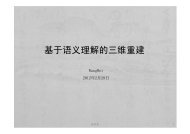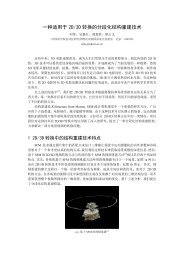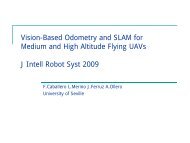Rotationally Invariant Descriptors using Intensity Order ... - IEEE Xplore
Rotationally Invariant Descriptors using Intensity Order ... - IEEE Xplore
Rotationally Invariant Descriptors using Intensity Order ... - IEEE Xplore
Create successful ePaper yourself
Turn your PDF publications into a flip-book with our unique Google optimized e-Paper software.
This article has been accepted for publication in a future issue of this journal, but has not been fully edited. Content may change prior to final publication.<br />
<strong>IEEE</strong> TRANSACTION ON PATTERN ANALYSIS AND MACHINE INTELLIGENCE 11<br />
features of sample points in these groups are pooled together separately to construct a descriptor.<br />
Since the intensity orders of sample points are rotation invariant, such a feature pooling scheme<br />
is also rotation invariant. Therefore, no orientation is required for reference in our method. In<br />
this paper, we pool two kinds of local features based on intensity orders to construct local<br />
image descriptors: one based on gradients and the other on intensities, hence two descriptors are<br />
obtained, named MROGH and MRRID respectively. The details will be described next.<br />
A. Affine Normalized Regions<br />
The detected regions for calculating descriptors are either circular or elliptical regions of<br />
different sizes based on the used region detectors. For example, the Hessian-Affine/Harris-<br />
Affine detector detects elliptical regions that are affine invariant up to a rotation transformation,<br />
while the Hessian-Laplace/Harris-Laplace detects circular regions. Please see [21], [22] for more<br />
details about region detectors. To obtain scale or affine invariance, the detected region is usually<br />
normalized to a canonical region. Similar to many other local descriptors, this work is to design<br />
local descriptor of the normalized region, which is a circular region of radius 20.5 pixels. Thus<br />
the minimal patch that contains the normalized region is in size of 41 × 41 pixels. A similar<br />
patch size is also used in [22], [24]. If the detected region is larger than the normalized region,<br />
the image of the detected region is smoothed by a Gaussian kernel before region normalization.<br />
The standard derivation of Gaussian used for smoothing is set to be the size ratio of the detected<br />
region and the normalized region [22].<br />
Given a detected region denoted by a symmetrical matrix A ∈ℜ 2×2 , for any point X in the<br />
region, it satisfies:<br />
X T AX ≤ 1 (2)<br />
If A = 1<br />
c2 E where E is the identity matrix, then the region is a circular one and c is its radius,<br />
otherwise it is an elliptical region. The normalization aims to warp the detected region into a<br />
canonical circular region as shown in Fig. 4. The sample point X ′ belonging to the normalized<br />
region satisfies:<br />
X ′T X ′ ≤ r 2<br />
where r is the radius of the normalized region, which is set to 20.5 pixels in this paper. Combining<br />
November 26, 2011 DRAFT<br />
(3)



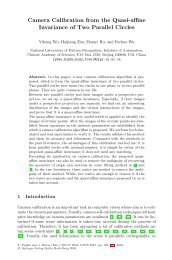
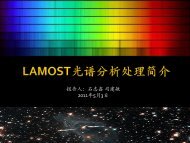
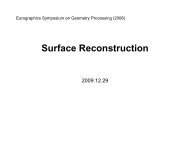
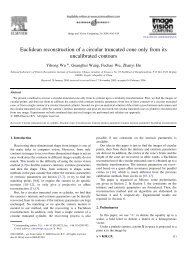
![Accurate, Dense, and Robust Multi-View Stereopsis (PMVS) [1,2,3]](https://img.yumpu.com/19388840/1/190x135/accurate-dense-and-robust-multi-view-stereopsis-pmvs-123.jpg?quality=85)



